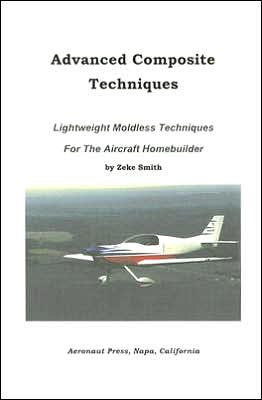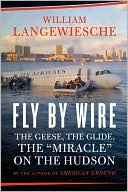Advanced Composite Techniques: Lightweigh Moldless Techniques for the Aircraft Homebuilder
This book will teach the non-engineer aircraft homebuilder how to make very light high performance composite structures using simple techniques and materials generally available at a home supply store.\ Simple vacuum-bagging techniques, using flat tools suitable for the homebuilder, are described in detail. A 17-step self-teaching course allows the reader to progress from the simplest flat open layup to a nearly full-scale, closed, wing section.\ The basic technique taught is the cored skin,...
Search in google:
This book will teach the non-engineer aircraft homebuilder how to make very light high performance composite structures using simple techniques and materials generally available at a home supply store. Simple vacuum-bagging techniques, using flat tools suitable for the homebuilder, are described in detail. A 17-step self-teaching course allows the reader to progress from the simplest flat open layup to a nearly full-scale, closed, wing section. The basic technique taught is the cored skin, where thin glass skins are bonded to very thick light-weight cores, producing very stiff, efficient, light-weight panels. Several different techniques for forming and bonding these panels are described These techniques will be very useful to any builder who is considering adapting an aircraft to the FAA Light Sport Aircraft rules of 2004, especially the Experimental Light Sport Aircraft type.
Introduction1What's Different1What We Will Do1Acknowledgements3Chapter 1Basic Principles of Composites5Composite Structures6Examples of Composites8Wood as a Composite8Panels9The Buckling Problem9Torsion11Sandwich Structures11Attachments - Distributed Loads12Environmental Factors - Postcuring12Basic Materials13Reinforcing Fibers14Matrix Materials14Core Materials14Adhesives15Fillers15Gelcoats - Why Everybody Else Uses Them16Chapter 2Overview of Techniques19Handling and Cutting Glass Cloth19Measuring and Mixing Resin21Wetting Out22Handling Core Materials23Foams as Cores24Foams as Forms for Skins25Forming Gently Curved Surfaces25Foam Added to Previously Formed Skins26Cutting Foam26Bending Foam Sheets27Bending Thick Foam Sheets28Use of Vacuum Bagging28Basic Vacuum Bagging Components29Basic Setup29Effect of Vacuum30Chapter 3Basic Materials Handling33Shop Safety - Important!33Storing Epoxy34Cleanup35Measuring Epoxy36Glass Cloth39Marking Cloth and Plastic Films39Tinting Resin41Thixotropic Fumed Silica41Working Temperatures42Chapter 4Handling and Cutting Foam45Cutting Sheets46Carving Foam47Bevels47Perforating Foam Sheets48Attaching Foam to Temporary Forms50Hot Wire Cutting Polystyrene Foam51Splitting Polystyrene Foam Blocks53Curved Shapes - Wings54Attaching Foam to Foam56Splicing Sheets and Blocks56The Problem of Sanding Hard Micro57Hot-wire Cutting Block Joints57Temperature Limitations58Glues58Bending Unskinned Foam Sheets59Bending Thick Flat Panels60Bending Slotted Sheets60Bonding Slotted Cores62Laminating Cores64Chapter 5Basic Layup Techniques65Basic Wetting-out Techniques65The "Prepreg" Sandwich69Wet Glass Tape69Bonding Fiber Skins to Foam71Applying Dry Glass to Foam72Applying Wetted Glass to Foam75Chapter 6Flat Tool Vacuum Bagging77Flat Tool Techniques78The Basic Vacuum Bag Process79Practical Techniques84Vacuum Plumbing System84Vacuum Control and Measurement87Bag Material87Bag Sealing88Leak Detection, Location and Repair89Envelope Bagging90Flat Tool Mold Release Techniques91Placing Tool Release Film91Toolside Bleeding93Double Bagging and Joggles94Bagside Surface Finish95Effect of Thick Cores96Caul Plates96Chapter 7Joints and Adhesives99Trimming Cured Skins99"Green" Trimming of Glass Skins99Knife Trim of Cured Skin with Local Heat100Router-like Tools101Band Saws101The Nature of Adhesives101The Basic Sheared Adhesive Joint101Real Adhesive Joints103Practical Adhesives104Methacrylate Adhesives105The Secondary Bond - A Compromise108Peeling108Bonded Joints109Vibration Considerations111Edges111Tacking Tape113Alignment, Clamping, and Inspection114Trial Assembly115Bonding116Chapter 8Taping and Basic Corners117Basic Tape-making117Corner Bonding119Fillets119Applying Tape121The "Lost Bondo" Corner121The Pipe-formed Corner124Oblique Corners - The "Barrel Joint"126Applying "Planks"127The "Forming Spool" Self-jigging Trick130A Hybrid Variation131Boat-building Considerations131Chapter 9Formed Curves and Corners133Bending Single-skin Foam133Folded Corners133Bending Slotted Sheets135The Short-radius Folded Joint136The Cored Corner139Joggles in Folded Joints141"Green" Folding141The Vision Aircraft Example142Comparison with Conventional Methods146Chapter 10Flanges and Closing147The Closing Problem147Use of the Flange Tool147Closing Operations154Trial Fitting154Bonding the Closure155Chapter 11Attachments159Load Transitions159Load Matching159Relation to Standard Practice160Practical Bolt Attachments161The Stub Web164"Synthetic Spruce"165Chapter 12Single-Curved Molds169Sheet Molds169Shaping the Mold Sheet171Using A Single-curved Mold174Very Shaply-curved Molds175Chapter 13Molding Techniques179Small-shop Commercial Practice179General Principles180Making The Mold183Partitioning The Mold184Mold Flanges186Producing a Part From A Mold186Small-shop Commercial Practice186Home-builder Molding Practice187Exercise 1Basic Open Flat Layup189Exercise 2The Basic "Transfer" Layup197Exercise 3Basic Vacuum Bagging203Exercise 4Making Accurate "Prepregs"209Exercise 5The Flat Sandwich Laminate213Exercise 6The Cored-skin Sandwich219Exercise 7Bonding Panels229Exercise 8Vacuum Release Film Experiment239Exercise 9Flat Cored Panels243Exercise 10Forming and Joining253Exercise 11Mailbox Door and Finishing259Exercise 12Flat-sided Fuselage Simulation267Exercise 13Single-curved Wing Skin Mold279Exercise 14Single-curved Wing Skin297Exercise 15Wing Skin Ribs And Webs305Exercise 16Bottom Wing Skin313Exercise 17Wing Closing Flanges313Appendix 1321General Tools321Common Tools322Drills320Power Saws320Rotary Tools321Work Area, Benches, and Storage322Temperature Control326Resin Storage326Postcuring329Standard Composite Tools331Measuring Epoxy333Ratio Pumps333Ratio Balances334Foam Tools337Hot Wire Cutters337Perforating Foam340Perforator Construction342Foam Beveling Tool343Beveling Tool Construction344Appendix 2Very Elementary Beam Theory345Trusses And Beams345Relationship To A Practical Cored Panel350Appendix 3Fibers, Weaves & Matrices353Why We Use Structural Fibers353Theoretical And Actual Strength353Strain And Stiffness354Fiber Materials - Summary355Strands, Yarns, and Roving355Design Strength Of Yarns356Weaves359Non-woven Fibers359Woven Fibers360Matrix Materials361Polyesters361Disadvantages of Polyesters362Epoxy Matrices362








